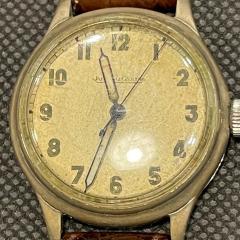-
Similar Content
-
Recently Browsing
- No registered users viewing this page.
-
Topics
-
Posts
-
By Neverenoughwatches · Posted
Post some pictures , some good close ones of the parts you've described. -
By Neverenoughwatches · Posted
Ive never used epilame H only information i have read and mentally stored about it mostly from Nicklesilver here and elsewhere ( the fork horns thing ), maybe the residue powder that is removed has some grinding effect ? So probably a good idea to limit its application areas to only the absolute necessary. Yes as far as i know epilame rubs off relatively easy, the technique of running the watch to make a groove through it first in the pallet stones where the lubrication is then placed. This i understand creates the barrier for the lube to sit up to. If i can find a good balance of pros and cons of its use then thats one process i can avoid by using a thixotropic lube on the stones. The epilame i would say allows for a more fluid lubrication to be used that would increase amplitude on low beat movements. The stearic acid powder is extremely cheap, the problem is the fuming process to coat parts, is not selective , the whole part has to treated in this method. If epilame residue can cause wear then thats not good, if I remember the conclusion was not proved entirely just a general assumption between watchmakers. The thread is out there somewhere, the same discussion is also old on a facebook group. Ive never used epilame H only information i have read and mentally stored about it mostly from Nicklesilver here and elsewhere ( the fork horns thing ), maybe the residue powder that is removed has some grinding effect ? So probably a good idea to limit its application areas to only the absolute necessary. Yes as far as i know epilame rubs off relatively easy, the technique of running the watch to make a groove through it first in the pallet stones where the lubrication is then placed. This i understand creates the barrier for the lube to sit up to. If i can find a good balance of pros and cons of its use then thats one process i can avoid by using a thixotropic lube on the stones. The epilame i would say allows for a more fluid lubrication to be used that would increase amplitude on low beat movements. The stearic acid powder is extremely cheap, the problem is the fuming process to coat parts, is not selective , the whole part has to treated in this method. If epilame residue can cause wear then thats not good, if I remember the conclusion was not proved entirely just a general assumption between watchmakers. The thread is out there somewhere, the same discussion is also old on a facebook group. If its a potential problem for amateurs to use then i would prefer not to take the risk . -
Following on from my question about identifying screws in the AS2063 movement that basically fell out of the case in bits, I’m pleased to report that I’ve got it all back together, and the movement is running pretty well. But… There’s something wrong with the keyless works and hand setting. It’s fine in winding and quickset date position - these work - but in hand setting position winding the crown turns the whole gear train. I don’t really understand how it’s meant to work. It doesn’t have a traditional friction fit cannon pinion. The second wheel is unusual with a pair of smaller pinions on it, which seem to interact with the barrel and the motion works. Could this be the problem? I must admit I just cleaned it and popped it in place when reassembling the gear train. I’ve lubricated the pivots but didn’t do anything to the extra bits on the second wheel. Does this make sense and is anyone able to figure out what I’m doing wrong? Thanks in advance, as always. ETA - the parts list calls it the Great Wheel, not second wheel.
-
You're thinking metal to jewel in general I guess. Maybe it would be a good idea to peg the pallet staff jewel hole on the main plate after the epilame treatment. I think that could work as it is my impression that the epilame doesn't sit very hard, but I could be wrong about that so feel free to educate me. I didn't remember that 9501 was thixotropic (thanks for the link). That would mean it's even runnier during impact (lower viscosity) so perhaps it's time I get some fresh grease as mine seems a bit too runny. What I have seen is a whitish surface after washing but it goes away if I scrub the surface with a brush in a degreaser (Horosolv). I don't think it embeds itself in the metal but sticks very hard to the metal. I don't worry too much about the cleaning solution. I just want perfectly clean parts and my solution can be replaced for little money (ELMA RED 1:9). Anyway, I quite often need "to strip back and rebuild" and scrubbing parts by hand isn't exactly the most stimulating part of a service. Just got confirmation that Moebius 9501 has a lower viscosity (68 cSt at 20° C) than 9504 (305 cSt at 20°). The viscosity of Molykote DX is 285-315 cSt at -25° to +125° C. I was surprised to see that the viscosity of Moebius 9010 (thin oil!) is higher (150 cSt at 20°) than my 9501 grease!
-
I’ve had a couple movements where it is clear the previous watchmaker was diligent with lubrication but the old epilam had turned to a fine white powder covering the pallet fork and keyless parts, which can’t be good for parts. I’m spare with epi since I don’t know how long it takes to degrade to that state…
-










Recommended Posts
Join the conversation
You can post now and register later. If you have an account, sign in now to post with your account.
Note: Your post will require moderator approval before it will be visible.